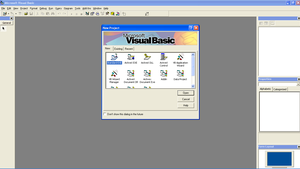
Back فيجوال بيسك Arabic فجوال بيسك ARZ Visual Basic Azerbaijani Visual Basic Bulgarian ভিজুয়াল বেসিক Bengali/Bangla Visual Basic BS Visual Basic Catalan Visual Basic Czech Visual Basic Danish Visual Basic Classic German
 | |
 Visual Basic 6.0 IDE running on Windows XP | |
| Paradigm | Object-based and event-driven |
|---|---|
| Developer | Microsoft |
| First appeared | May 1991 |
| Final release | 6.0
/ 1998 |
| Typing discipline | Static, strong |
| OS | Microsoft Windows and MS-DOS |
| Website | learn |
| Major implementations | |
| Microsoft Visual Studio | |
| Influenced by | |
| BASIC, Microsoft BASIC, QBasic | |
| Influenced | |
| Visual Basic .NET, Visual Basic for Applications, Windows Forms, Gambas, Xojo, Basic4ppc, Basic4android, and NS Basic | |
Visual Basic (VB), sometimes referred to as Classic Visual Basic,[1][2] is a third-generation programming language based on BASIC, as well as an associated integrated development environment (IDE). Visual Basic was developed by Microsoft for Windows, and is known for supporting rapid application development (RAD) of graphical user interface (GUI) applications, event-driven programming, and both consumption and development of components via the Component Object Model (COM) technology.
VB was first released in 1991. The final release was version 6 (VB6) in 1998. On April 8, 2008, Microsoft stopped supporting the VB6 IDE, relegating it to legacy status. The Microsoft VB team still maintains compatibility for VB6 applications through its "It Just Works" program on supported Windows operating systems.[3]
Visual Basic .NET (VB.NET) is based on Classic Visual Basic. Because VB.NET was later rebranded back to Visual Basic, the name is ambiguous: it can refer to either Classic Visual Basic or to the .NET version.
Just as BASIC was originally intended to be easy to learn, Microsoft intended the same for VB.[4][5]
Development of a VB application is exclusively supported via the VB integrated development environment (IDE), an application in the contemporary Visual Studio suite of tools. Unlike modern versions of Visual Studio, which support many languages including VB (.NET), the VB IDE only supports VB.
In 2014, some software developers still preferred Visual Basic 6.0 over its successor, Visual Basic .NET.[6] Visual Basic 6.0 was selected as the most dreaded programming language by respondents of Stack Overflow's annual developer survey in 2016, 2017, and 2018.[7][8][9]
- ^ "The Classic Visual Basic Programming Language". TIOBE. Retrieved 2023-02-07.
- ^ "Classic VB". Visual Studio Magazine. Retrieved 2024-08-29.
- ^ "Support Statement for Visual Basic 6.0 on Windows (updated with Windows 10 version 1709 support information)". Microsoft. Retrieved 2015-10-15.
- ^ Root, Randal; Romero Sweeney, Mary (2006). A tester's guide to .NET programming. Apress. p. 3. ISBN 978-1-59059-600-5.
You can choose a language based on how easy it is to learn. For beginners, Visual Basic is a good choice. [~snip] A big advantage of Visual Basic is that it is a popular language since it is easy to learn.
- ^ Plant, Robert T.; Murrell, Stephen (2007). An executive's guide to information technology. Cambridge University Press. p. 343. ISBN 978-0-521-85336-1.
Summary of positive issues: Visual Basic is easy to learn and widely available.
- ^ Cite error: The named reference
ISpliterwas invoked but never defined (see the help page). - ^ "Stack Overflow Developer Survey 2016". Stack Overflow. 2016. Retrieved 2020-12-18.
- ^ "Stack Overflow Developer Survey 2017". Stack Overflow. 2017. Retrieved 2020-12-18.
- ^ "Stack Overflow Developer Survey 2018". Stack Overflow. 2018. Retrieved 2020-12-18.